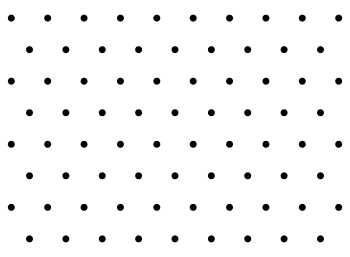Lattice (music)


In musical tuning, a lattice "is a way of modeling the tuning relationships in a just intonation system. It is an array of points in a periodic multidimensional pattern. Each point on the lattice corresponds to a ratio (i.e., a pitch, or an interval with respect to some other point on the lattice). The lattice can be two-, three-, or n-dimensional, with each dimension corresponding to a different prime-number partial"[1] or chroma.
Examples of musical lattices include the Tonnetz of Euler (1739) and Hugo Riemann and the tuning systems of Ben Johnston. Musical intervals in just intonation are related to those in equal tuning by Adriaan Fokker's Fokker periodicity blocks. Many multi-dimensional higher limit tunings have been mapped by Erv Wilson. The limit is the highest prime-number partial used in a tuning.
Thus Pythagorean tuning, which uses only the perfect fifth (3/2) and octave (2/1) and their multiples (powers of 2 and 3), is represented through a two-dimensional lattice, while standard (5-limit) just intonation, which adds the use of the just major third (5/4), may be represented through a three-dimensional lattice though "a twelve-note 'chromatic' scale may be represented as a two-dimensional (3,5) projection plane within the three-dimensional (2,3,5) space needed to map the scale. (Octave equivalents would appear on an axis at right angles to the other two, but this arrangement is not really necessary graphically.)".[1] In other words the circle of fifths on one dimension and a series of major thirds on those fifths in the second (horizontal and vertical), with the option of using depth to model octaves:
A----E----B----F#+ | | | | F----C----G----D | | | | Db---Ab---Eb---Bb
Equals the ratios:
5/3--5/4-15/8--45/32 | | | | 4/3--1/1--3/2---9/8 | | | | 16/15-8/5-6/5---9/5

Erv Wilson has made significant headway with developing lattices than can handle higher limit harmonics. Here is a template he used to generate what he called an “Euler“ lattice after where he drew his inspiration. Each prime harmonic has a unique spacing , avoiding clashes even when generating lattice of multidimensional harmonically-based structure
Some other features worth pointing out are that are harmonically generated intervals will always appear above the fundamental and the subharmonics below. With a 9-limit system the direction will be both above and to the right , leaving the other quadrant for more complex ratios with the opposite with the subharmonic. This makes it quite easy to understand what is being represented.
Commonly he would use a 10 square to the inch graph paper which explains why he didn’t use a template where all the numbers where divided by 2. This way he had room to notate both ratios and often the scale degree. The latter always followed by a period or dot to separate it from the ratios. Numerous examples appear throughout the Wilson Archives

See also
Sources
- ↑ 1.0 1.1 Gilmore, Bob (2006). "Introduction", p.xviii, "Maximum Clarity" and Other Writings on Music, edited by Bob Gilmore. Urbana: University of Illinois Press. ISBN 0-252-03098-2.
Further reading
- Johnston, Ben (2006). "Rational Structure in Music", "Maximum Clarity" and Other Writings on Music, edited by Bob Gilmore. Urbana: University of Illinois Press. ISBN 0-252-03098-2.